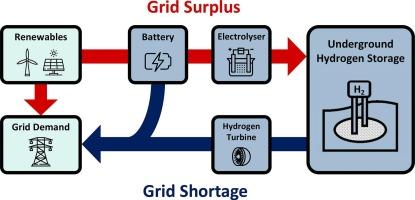模拟氢储存需求以平衡未来西澳大利亚电网
IF 10.9
1区 工程技术
Q1 ENERGY & FUELS
引用次数: 0
摘要
在间歇性方面,增加可再生能源技术对电网的渗透以实现二氧化碳净零排放目标是一项关键挑战;一个解决方案是提供足够的能量储存。在当前的研究中,我们考虑了西澳大利亚州西南互联系统电网的电力需求和可再生能源的未来预测(2042年)。所需要的能量存储考虑的是电池储能系统和地下储氢在枯竭气藏的混合物。西南互联系统是一个很好的案例研究,因为它是一个相对较大的、孤立的电网,具有可再生能源的巨大潜力,以及潜在的地下储氢场所。这项工作利用了一个动态的能量模型,以小时为基础汇总风能和太阳能资源。过剩的能源首先利用电池储能系统的容量,其次是地下储氢。然后,可再生能源的相对规模和存储选项在最大限度地降低批发能源生产成本方面得到优化。对整个集成系统的独特优化分析清楚地表明,电池储能系统和地下储氢系统都是必需的;地下储氢主要是为了满足季节性未满足的能源需求,约占总需求的6%。地下储氢成本主要取决于所需的电解槽要求。优化后的平准化电力成本为106美元/兆瓦时,比目前的批发电价高出约45%。本文章由计算机程序翻译,如有差异,请以英文原文为准。

Modelling hydrogen storage requirements to balance the future Western Australian grid
Increasing renewable energy technology penetration into electrical grids to meet net zero CO2 emission targets is a key challenge in terms of intermittency; one solution is the provision of sufficient energy storage. In the current study we considered future projections of electrical demand and renewable energy (in 2042) for the Southwest Interconnected System grid in Western Australia. Required energy storage considered is a mixture of battery energy storage systems and underground hydrogen storage in a depleted gas reservoir. The Southwest Interconnected System serves as an excellent case study given that it is a comparatively large, isolated grid with substantial potential access to renewable energy resources as well as potential underground hydrogen storage sites. This work utilised a dynamic energy model that summates the wind and solar energy resources on an hourly basis. Excess energy utilised battery energy storage systems capacity first, followed by underground hydrogen storage. The relative size of the renewables and the storage options is then optimised in terms of minimising wholesale energy production costs. This unique optimisation analysis across the full, integrated system clearly indicated that both battery energy storage systems and underground hydrogen storage are required; underground hydrogen storage is predominately necessary to meet seasonal unmet energy demand that amounts to approximately 6% of total demand. Underground hydrogen storage costs were dominated by the required electrolyser requirements. The optimised levelised cost of electricity was found to be US$106/MWh, which is approximately 45% larger than current wholesale electricity prices.
求助全文
通过发布文献求助,成功后即可免费获取论文全文。
去求助
来源期刊

Energy Conversion and Management
工程技术-力学
CiteScore
19.00
自引率
11.50%
发文量
1304
审稿时长
17 days
期刊介绍:
The journal Energy Conversion and Management provides a forum for publishing original contributions and comprehensive technical review articles of interdisciplinary and original research on all important energy topics.
The topics considered include energy generation, utilization, conversion, storage, transmission, conservation, management and sustainability. These topics typically involve various types of energy such as mechanical, thermal, nuclear, chemical, electromagnetic, magnetic and electric. These energy types cover all known energy resources, including renewable resources (e.g., solar, bio, hydro, wind, geothermal and ocean energy), fossil fuels and nuclear resources.
 求助内容:
求助内容: 应助结果提醒方式:
应助结果提醒方式:


